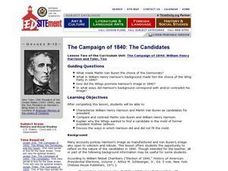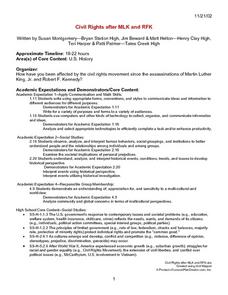Curated OER
The Election Is in the House: Was There a Corrupt Bargain?
Students take a stand, supported by evidence, on whether there was a "corrupt bargain" between Henry Clay and John Quincy Adams.
Curated OER
The Campaign of 1840: William Henry Harrison and Tyler, Too
High schoolers list some issues important during the campaign of 1840. They compare and contrast the careers of Martin Van Buren and William Henry Harrison before they became president and explain why the Whigs wanted to find a candidate...
Curated OER
You and the Judicial System
Students explore how the structure of the state and federal judicial systems affect them. They select an appropriate media and create a presentation on the structure of the judicial system, the criminal judicial system and a guide to the...
Curated OER
Measuring Matter
Explore various types of measurement with fourth graders. They will practice using balance pans to measure the weight of a coin and a graduated cylinder to determine the displacement volume for a bolt. The metric system will be the focus...
Curated OER
The Campaign of 1840: The Candidates
Students compare and contrast William Henry Harrison and Martin Van Buren as candidates for president. They explain why the Whigs wanted to find a candidate in the mold of former president Andrew Jackson and discuss whether Harrison fit...
Curated OER
The Era of Good Feelings
Setting the context for the first part of the 19th century, the slides presented here display the "Era of Good Feelings," including the presidencies of Monroe and Adams. Maps and photographs help students to contextualize the concepts of...
Curated OER
Andrew Jackson: 1767-1845
A thorough examination of Andrew Jackson's presidency and politics, these slides contain important facts and pictures of the growing United States. Events such as the Trail of Tears and the Tariff Battles of the early 19th century are on...
Curated OER
The Campaign of 1840: The Campaign
High schoolers discuss the use of visual images, objects, and spectacle in the 1840 campaign, then take a stand: Was the campaign of 1840 based more on substance or image?
Curated OER
The Campaign of 1840: The Whigs, the Democrats, and the Issues
High schoolers reflect on the nature of the campaign of 1840. They identify the positions of the Democrats and the Whigs and their basic differences.
Curated OER
The Jeffersonian Age: 1800 - 1824 (5)
In this online interactive American history worksheet, students answer 15 fill in the blank questions regarding the Jeffersonian Age. Students may submit their answers to be scored.
Curated OER
Civil Rights after MLK and RFK
Students are assigned to groups representing minority populations who produce a research project in a digital format from the list. A few of the choices are: speech, letter to the editor, editorial cartoon, etc.
Curated OER
The Ides March On - Caesar Today
Students make connections between the rule and reign of Julius Caesar and the leaders of other countries. They then create a news show that communicates their understanding of four essential questions that are included in the lesson.
Curated OER
Why Does Delaware Have Such A StrangeShape?
Middle schoolers examine the events and history surrounding the boundaries of Delaware. They participate in a class discussion and analyze a map, then create a floor map using masking tape. Students also participate in a play about the...
Curated OER
Circles Minilab
Learners learn how to measure the diameter and circumference of a circle. In this circle lesson, students organize their data to create a graph. Learners utilize their graph to make an inference about the slope of pi.















